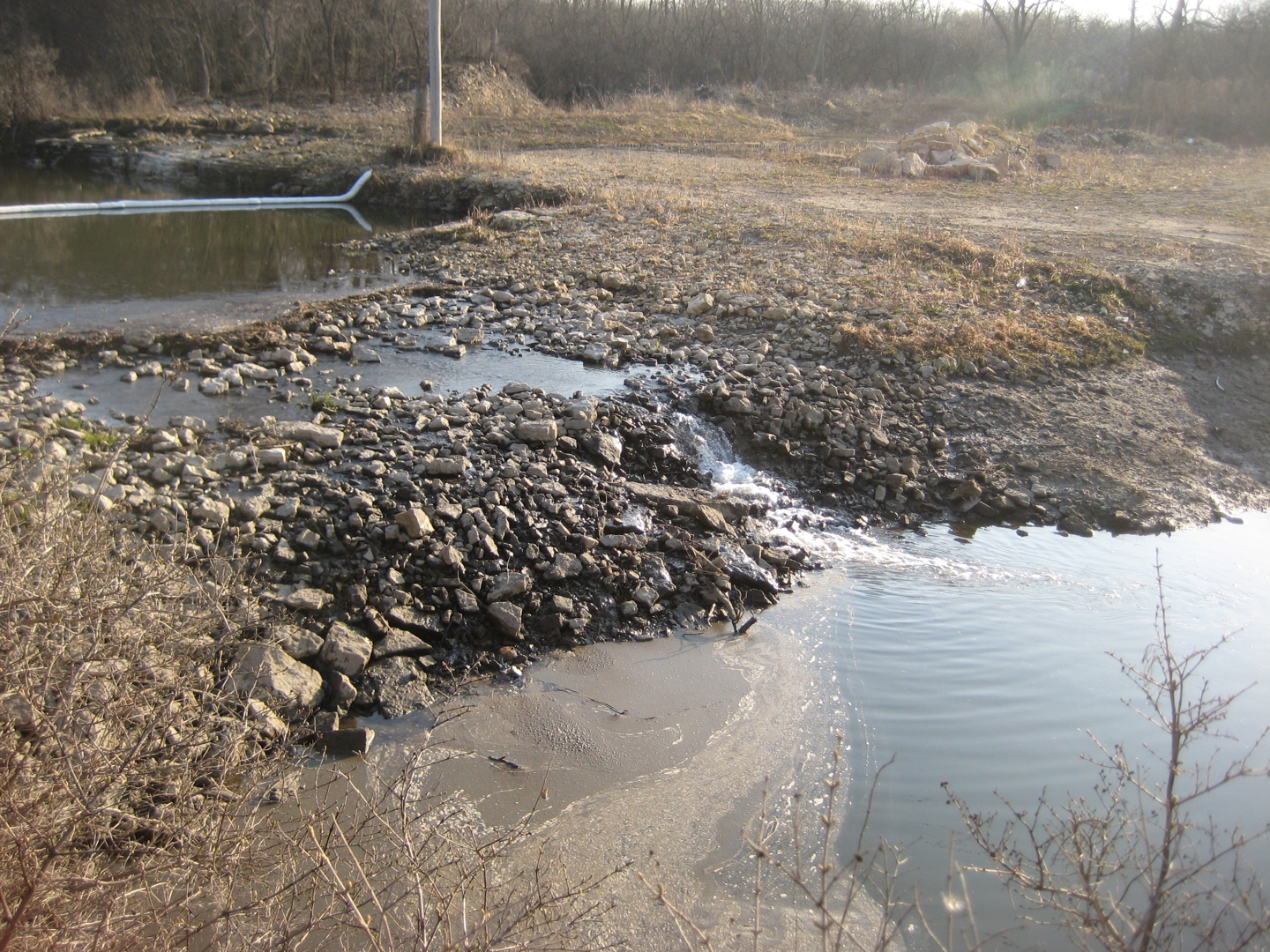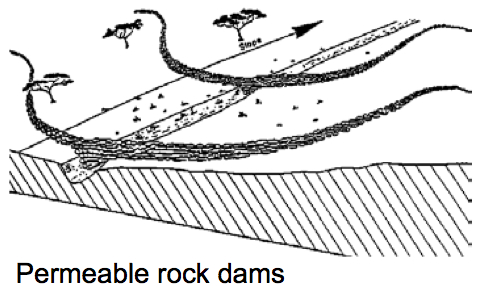Difference between revisions of "堆石透水坝"
| Line 1: | Line 1: | ||
[[Image:perm rock dam icon.png|right|80px]] | [[Image:perm rock dam icon.png|right|80px]] | ||
| − | [[Image:PermeableRockDam2.JPG|thumb|right|200px| | + | [[Image:PermeableRockDam2.JPG|thumb|right|200px|流水中的堆石透水坝。图片来源:[http://il.water.usgs.gov/asian_carp/images/IM_Canal/3-Illinois%20and%20Michigan%20Canal%20Flow%20Barrier_recent.JPG USGS.]]] |
__NOTOC__ <small-title /> | __NOTOC__ <small-title /> | ||
| − | + | 堆石透水坝由低矮的长形石墙构成,有数个等高且地势较高的位置,长度贯穿整座谷底。这样的构造能使水道侧部形成径流。这种洪水收集方法能分散并保留洪水径流,以促进庄稼生长,同时控制沟蚀。堆石透水坝可被视作为一种“梯田干谷”,虽然梯田干谷通常用来描述更干旱地区中水道内的结构。 | |
| − | + | 与钢筋石笼方法相比,堆石透水坝提供了更有效,应用也更广泛的技术来控制沟蚀。堆石透水坝除了有效控制沟蚀外,还大量增加了水坝后方农作物的产量。水坝后的淤泥使沟道修复,由于肥沃的淤泥沉积下来,最靠近坝后的土壤得以变得更深,质量更高。这也提高了农作物所需的湿度。与每公顷出产1吨高粱且未经处理的相应土地比较,在修建了堆石透水坝的土地上,高粱产量可高达每公顷1.9吨。其它可种于堆石透水坝背面的农作物有:大米(粘重土),御谷和花生。 | |
| + | ===适宜条件=== | ||
| + | 堆石透水坝可在下列情况中用于农作物生产: | ||
| − | + | * 降雨量:200–750毫米;干旱至半干旱地区 | |
| − | + | * 土壤:适用于所有农业土壤——较劣土壤可经处理后优化 | |
| + | * 坡度:低于2%为最佳,最有利于水的流散 | ||
| + | * 地形:宽浅的谷床 | ||
| − | + | 这一水坝系统通常用于相对宽浅的谷床。这项技术适用于年降雨量少于700毫米的地区,这些地区的沟道正在肥沃的土地中形成。这一水坝尤其适用于斜坡坡度小于2%的谷底,且当地可供给石块,具备交通运输条件。 | |
| − | |||
| − | |||
| − | |||
| − | |||
| − | |||
{| border="1" cellpadding="5" cellspacing="0" align="center" | {| border="1" cellpadding="5" cellspacing="0" align="center" | ||
|- | |- | ||
| − | ! width="50%" style="background:#efefef;" | | + | ! width="50%" style="background:#efefef;" | 优势 |
| − | ! style="background:#f0f8ff;" | | + | ! style="background:#f0f8ff;" | 不足 |
|- | |- | ||
| − | | valign="top" | - | + | | valign="top" | - 增加农作物产量,由收集、分流洪水来控制侵蚀 <br> |
| − | - | + | - 因肥沃的淤泥能淤积在沟道中,从而能优化土地管理<br> |
| − | - | + | - 加强地下水补给 <br> |
| − | | valign="top" | - | + | | valign="top" | - 减缓径流的流散,降低潜在的侵蚀可能<br> |
| − | - | + | - 高昂的交通运输成本 <br> |
| − | - | + | - 需要具备大量石材 <br> |
|} | |} | ||
<br> | <br> | ||
| − | === | + | ===建造、运作与维护=== |
| − | [[Image:PermeableRockDam.JPG|thumb|right|200px| | + | [[Image:PermeableRockDam.JPG|thumb|right|200px|堆石透水坝,斜坡方向如箭头所示。图片来源:SAI.]] |
| − | + | 水坝长度通常在50至300米之间。坝墙通常高一米(包含沟道),其余部分高80至150厘米。下坡侧坝墙(2:1)比上坡侧坝墙(1:2)平缓,为的是在坝满时结构更稳。地基上的浅渠提升了稳定性,降低了底蚀的风险。建坝的大石块用于外墙,而小石块用于坝体内部。 | |
| − | === | + | ===成本=== |
| − | + | 一座为2至2.5公顷土地控制侵蚀和供水的典型石坝需要500至650美元建材运输费,约300至600人力工作日。 | |
| − | === | + | ===实地经验=== |
| − | + | 在布基纳法索,已有数个组织加入普及这项技术的行列。建坝需要集中大量劳动力,也需要为大量石材提供机械化运输。申请实施这项技术的村庄通常支付一半的交通运输费、提供全部劳动力并管理水坝。在某些建有石坝的地区,也有个人土地主随后建造小型石坝。 | |
| − | + | 政府主要提供建造阶段所需的技术建议。近来,村庄应要求组建土地资源管理委员会,作为纽带,与农业推广人员协调土地与水资源管理的相关活动。由委员会起草土地使用管理计划,提供建坝及其它环境保护项目的规划参照。 | |
| − | === | + | ===指南,视频与链接=== |
* [http://www.nzdl.org/gsdlmod?e=d-00000-00---off-0fnl2.2--00-0----0-10-0---0---0direct-10---4-------0-1l--11-en-50---20-about---00-0-1-00-0--4----0-0-11-10-0utfZz-8-00&a=d&cl=CL3.31&d=HASHa7909460293ada0236fd7d.4.2.2.5 Sourcebook of Alternative Technologies for Freshwater Augmentation in Africa (UNEP-IETC, 1998, 182 p.)] or ([http://www.washdoc.info/docsearch/title/115176 alternative link]). UNEP. | * [http://www.nzdl.org/gsdlmod?e=d-00000-00---off-0fnl2.2--00-0----0-10-0---0---0direct-10---4-------0-1l--11-en-50---20-about---00-0-1-00-0--4----0-0-11-10-0utfZz-8-00&a=d&cl=CL3.31&d=HASHa7909460293ada0236fd7d.4.2.2.5 Sourcebook of Alternative Technologies for Freshwater Augmentation in Africa (UNEP-IETC, 1998, 182 p.)] or ([http://www.washdoc.info/docsearch/title/115176 alternative link]). UNEP. | ||
| − | === | + | ===鸣谢=== |
| − | * Rufino, L., [http://www.saiplatform.org/uploads/Library/Technical%20Brief%202%20%20Rainwater%20harvesting%20%20artificial%20recharge%20to%20groundwater.pdf | + | * Rufino, L., [http://www.saiplatform.org/uploads/Library/Technical%20Brief%202%20%20Rainwater%20harvesting%20%20artificial%20recharge%20to%20groundwater.pdf 水资源保护技术概要:TB 2 –雨水收集与人工地下水补给]. Sustainable Agriculture Initiative (SAI). 2009年8月。 |
| − | * Awulachew, Seleshi Bekele (IWMI); Lemperiere, Philippe (IWMI). [http://www.ilri.org/InfoServ/Webpub/fulldocs/IWMI_IPMSmodules/Module_2.pdf | + | * Awulachew, Seleshi Bekele (IWMI); Lemperiere, Philippe (IWMI). [http://www.ilri.org/InfoServ/Webpub/fulldocs/IWMI_IPMSmodules/Module_2.pdf 增产的集水与开发。] Tulu, Taffa (Adama University). 2009年1月。 |
| − | * [http://www.nzdl.org/gsdlmod?e=d-00000-00---off-0fnl2.2--00-0----0-10-0---0---0direct-10---4-------0-1l--11-en-50---20-about---00-0-1-00-0--4----0-0-11-10-0utfZz-8-00&a=d&cl=CL3.31&d=HASHa7909460293ada0236fd7d.4.2.2.5 | + | * [http://www.nzdl.org/gsdlmod?e=d-00000-00---off-0fnl2.2--00-0----0-10-0---0---0direct-10---4-------0-1l--11-en-50---20-about---00-0-1-00-0--4----0-0-11-10-0utfZz-8-00&a=d&cl=CL3.31&d=HASHa7909460293ada0236fd7d.4.2.2.5 非洲增加淡水替代技术资料读物 (UNEP-IETC, 1998, 182 p.)] or ([http://www.washdoc.info/docsearch/title/115176 alternative link]). UNEP. |
Revision as of 05:27, 29 August 2015

堆石透水坝由低矮的长形石墙构成,有数个等高且地势较高的位置,长度贯穿整座谷底。这样的构造能使水道侧部形成径流。这种洪水收集方法能分散并保留洪水径流,以促进庄稼生长,同时控制沟蚀。堆石透水坝可被视作为一种“梯田干谷”,虽然梯田干谷通常用来描述更干旱地区中水道内的结构。
与钢筋石笼方法相比,堆石透水坝提供了更有效,应用也更广泛的技术来控制沟蚀。堆石透水坝除了有效控制沟蚀外,还大量增加了水坝后方农作物的产量。水坝后的淤泥使沟道修复,由于肥沃的淤泥沉积下来,最靠近坝后的土壤得以变得更深,质量更高。这也提高了农作物所需的湿度。与每公顷出产1吨高粱且未经处理的相应土地比较,在修建了堆石透水坝的土地上,高粱产量可高达每公顷1.9吨。其它可种于堆石透水坝背面的农作物有:大米(粘重土),御谷和花生。
适宜条件
堆石透水坝可在下列情况中用于农作物生产:
- 降雨量:200–750毫米;干旱至半干旱地区
- 土壤:适用于所有农业土壤——较劣土壤可经处理后优化
- 坡度:低于2%为最佳,最有利于水的流散
- 地形:宽浅的谷床
这一水坝系统通常用于相对宽浅的谷床。这项技术适用于年降雨量少于700毫米的地区,这些地区的沟道正在肥沃的土地中形成。这一水坝尤其适用于斜坡坡度小于2%的谷底,且当地可供给石块,具备交通运输条件。
| 优势 | 不足 |
|---|---|
| - 增加农作物产量,由收集、分流洪水来控制侵蚀 - 因肥沃的淤泥能淤积在沟道中,从而能优化土地管理 |
- 减缓径流的流散,降低潜在的侵蚀可能 - 高昂的交通运输成本 |
建造、运作与维护
水坝长度通常在50至300米之间。坝墙通常高一米(包含沟道),其余部分高80至150厘米。下坡侧坝墙(2:1)比上坡侧坝墙(1:2)平缓,为的是在坝满时结构更稳。地基上的浅渠提升了稳定性,降低了底蚀的风险。建坝的大石块用于外墙,而小石块用于坝体内部。
成本
一座为2至2.5公顷土地控制侵蚀和供水的典型石坝需要500至650美元建材运输费,约300至600人力工作日。
实地经验
在布基纳法索,已有数个组织加入普及这项技术的行列。建坝需要集中大量劳动力,也需要为大量石材提供机械化运输。申请实施这项技术的村庄通常支付一半的交通运输费、提供全部劳动力并管理水坝。在某些建有石坝的地区,也有个人土地主随后建造小型石坝。
政府主要提供建造阶段所需的技术建议。近来,村庄应要求组建土地资源管理委员会,作为纽带,与农业推广人员协调土地与水资源管理的相关活动。由委员会起草土地使用管理计划,提供建坝及其它环境保护项目的规划参照。
指南,视频与链接
- Sourcebook of Alternative Technologies for Freshwater Augmentation in Africa (UNEP-IETC, 1998, 182 p.) or (alternative link). UNEP.
鸣谢
- Rufino, L., 水资源保护技术概要:TB 2 –雨水收集与人工地下水补给. Sustainable Agriculture Initiative (SAI). 2009年8月。
- Awulachew, Seleshi Bekele (IWMI); Lemperiere, Philippe (IWMI). 增产的集水与开发。 Tulu, Taffa (Adama University). 2009年1月。

